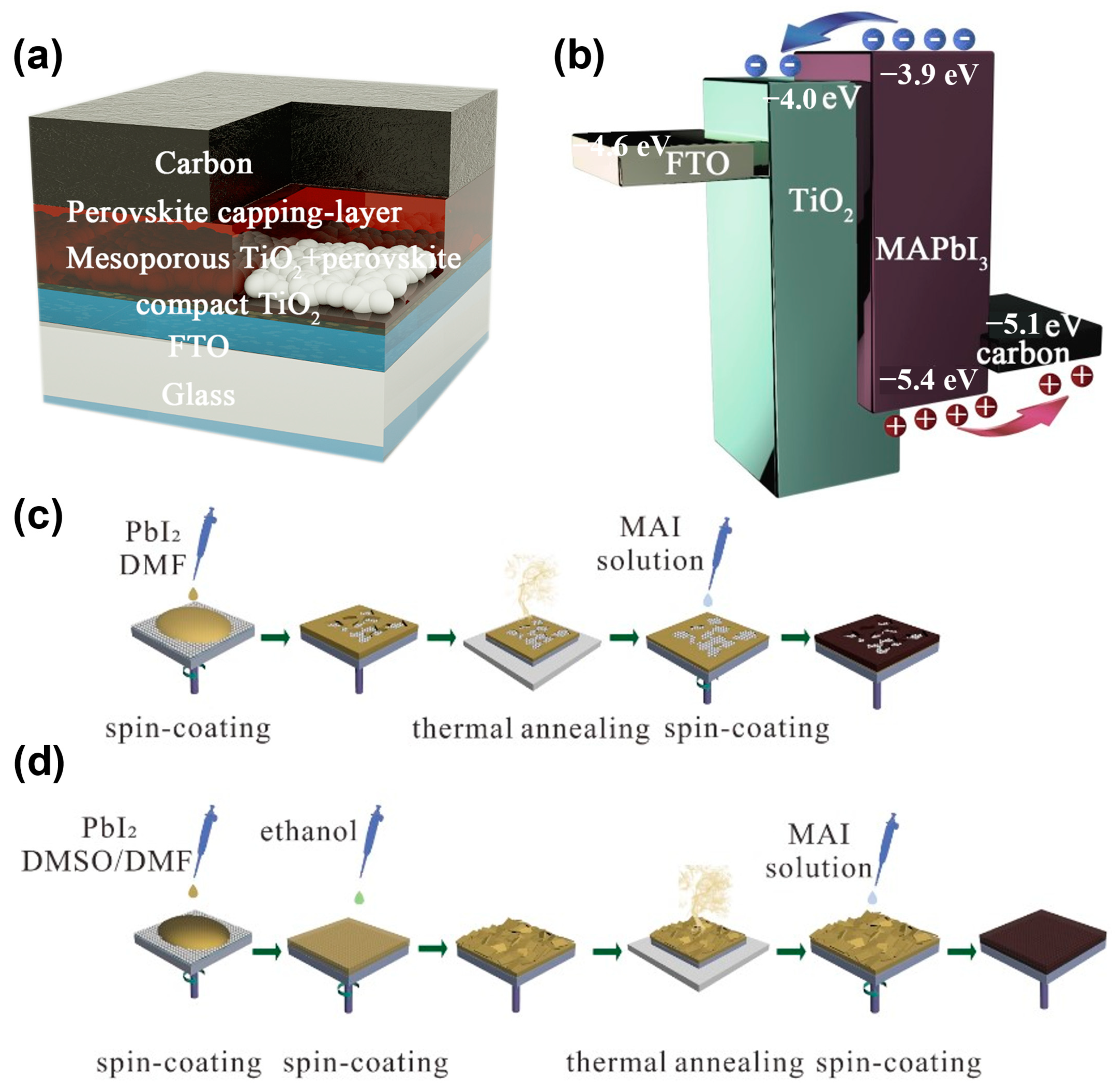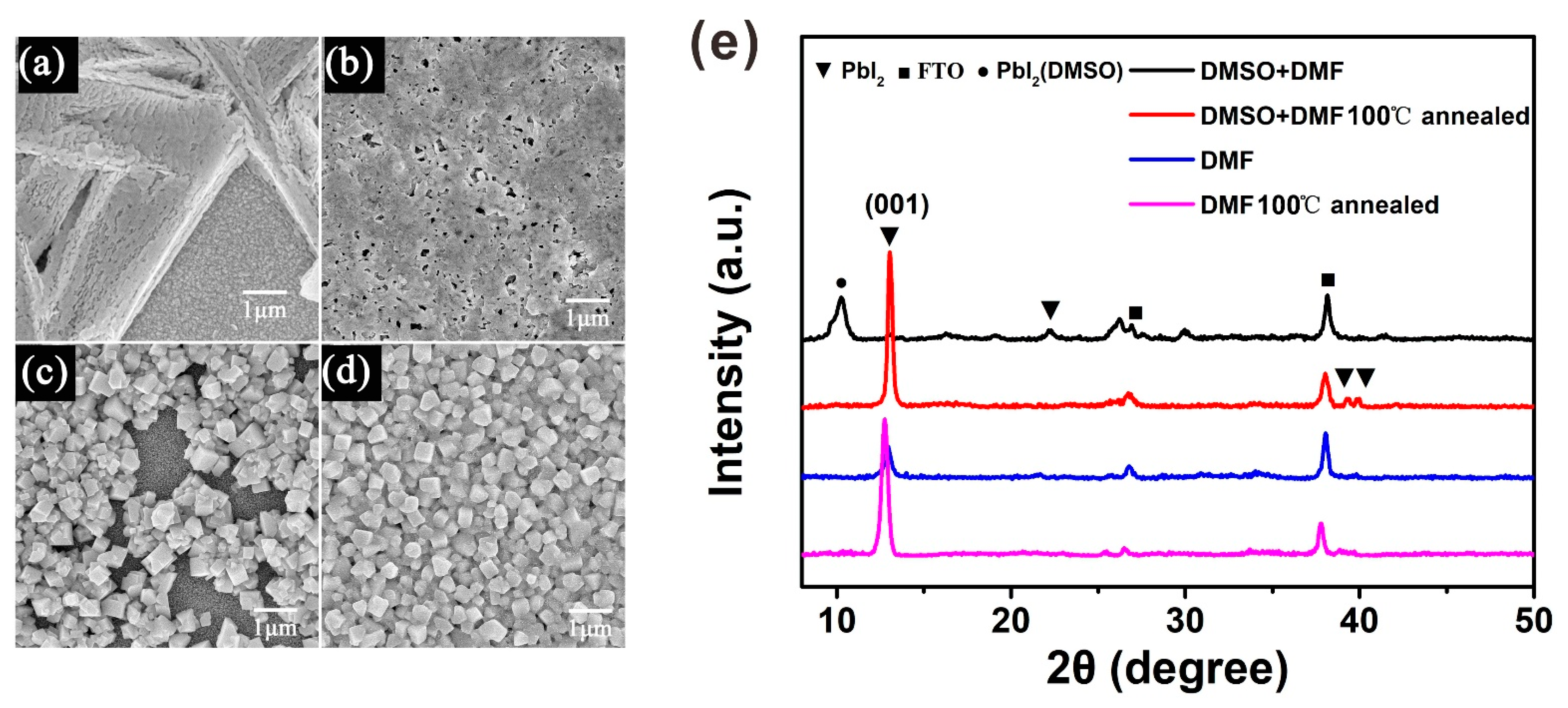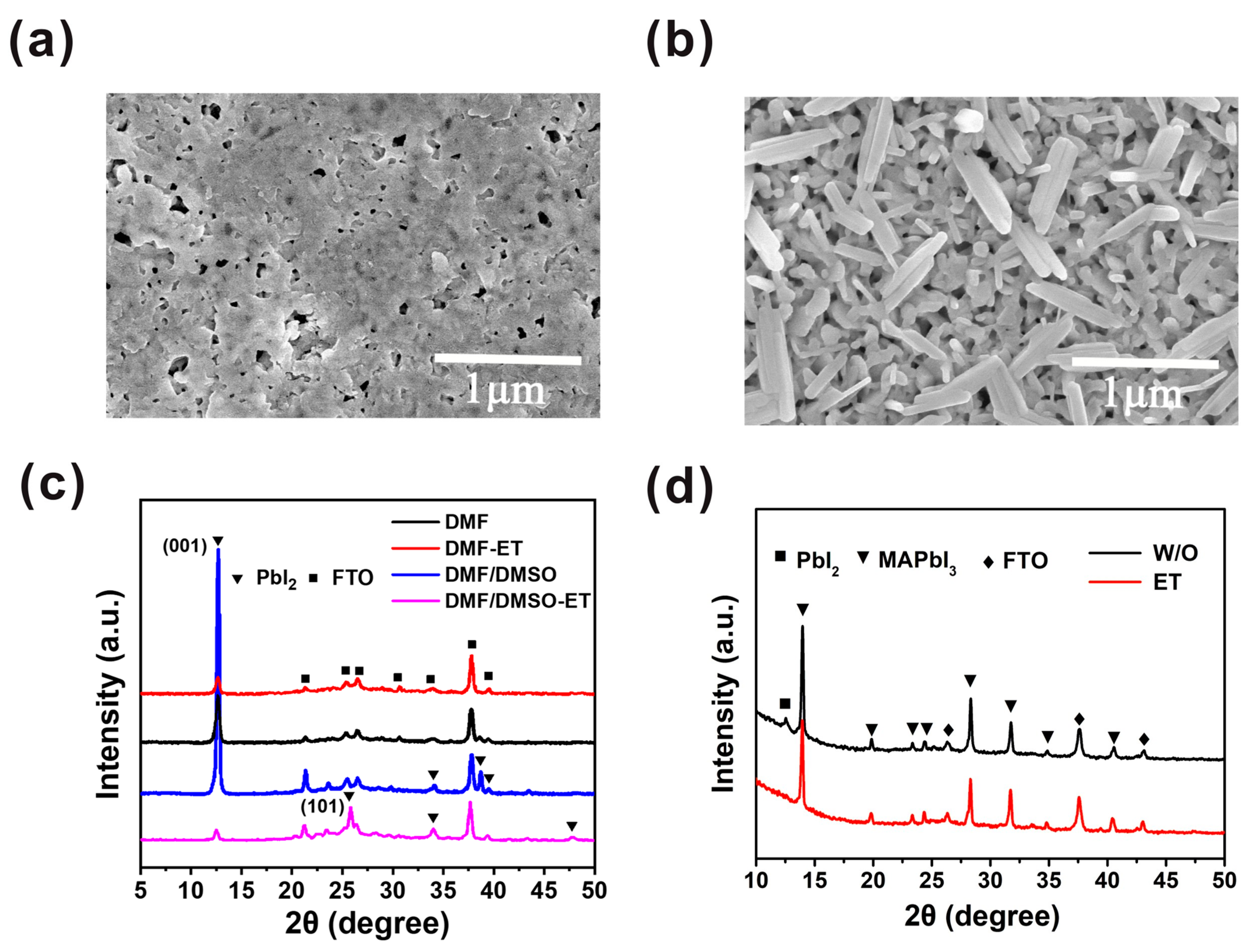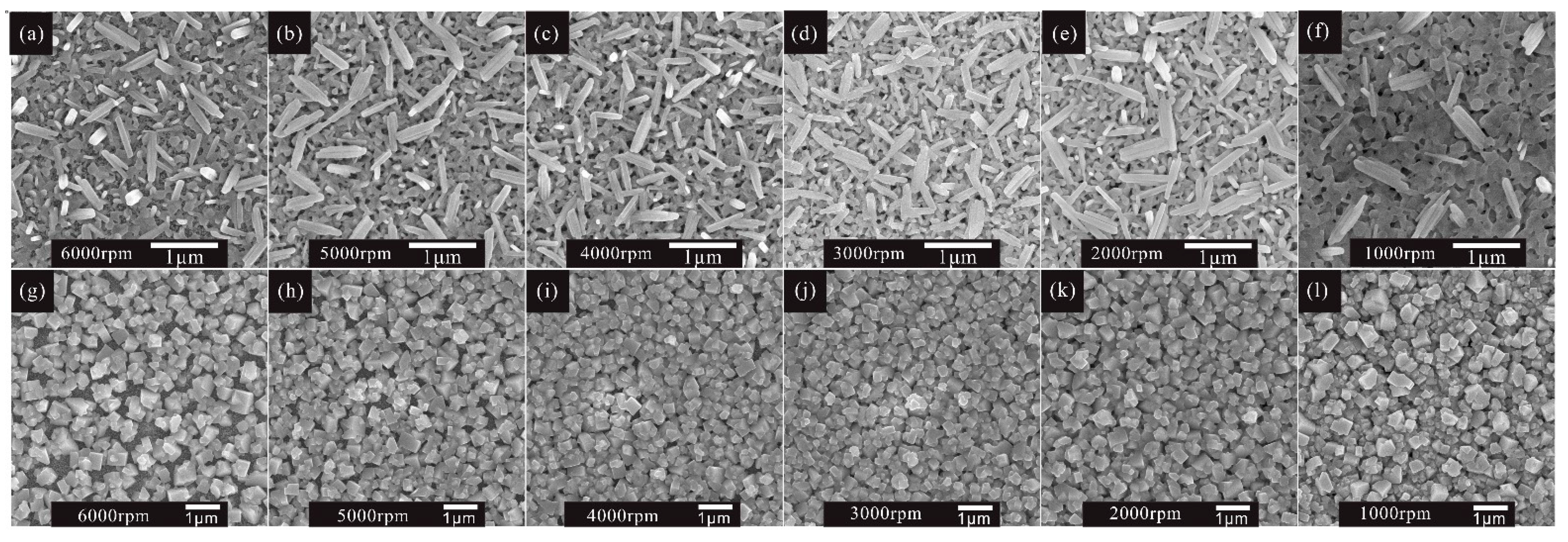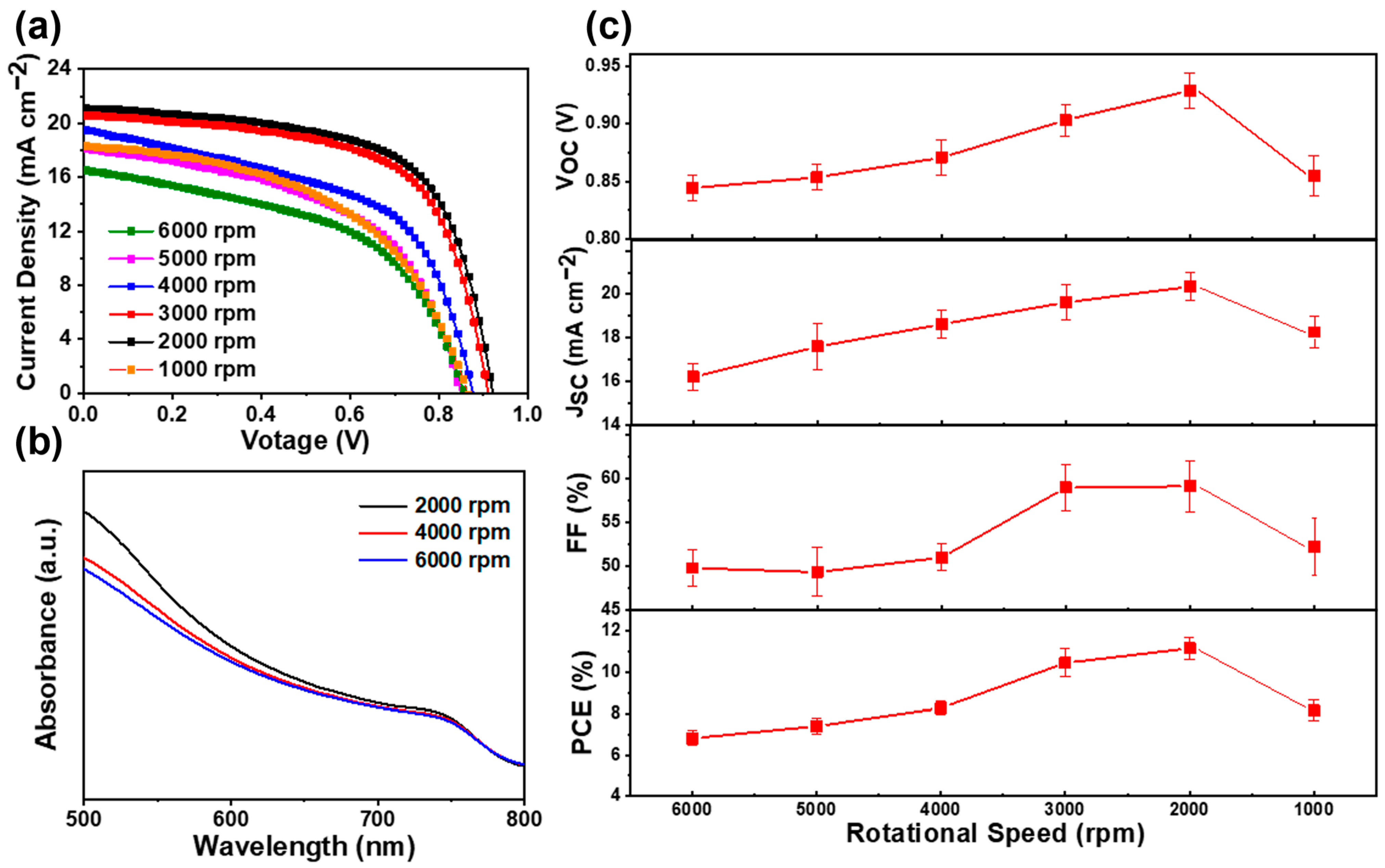1. Introduction
Lead halide perovskites have excellent optoelectronic properties, such as a high absorption coefficient, high carrier mobility, and long carrier recombination life. Due to these excellent properties, the PCE of perovskite solar cells (PSCs) achieved an explosive development from 3.8% to 25.7% in a few years [
1,
2,
3,
4,
5,
6]. Despite the advance in the PCE of PSCs, the moisture instability of the perovskite layer, under ambient conditions, is one of the most urgent problems to be resolved.
As known to us all, the moisture instability of the perovskite layer reduces the lifetime of the solar cells and, thus, limits their application outdoors. Under the combined action of humidity, oxygen, and ultraviolet light, the perovskite active layer will rapidly decompose [
7,
8,
9,
10]. Moreover, the majority of PSCs use hole transport material (HTM) to facilitate hole extraction. (
N,
N-di-methoxy-phenyl amine)-9,9-spirobifluorene (spiro-OMeTAD) is a common hole transport material in perovskite solar cells, usually doped with bis(trifluoromethane)sulfonimide lithium salt to improve its conductivity. However, lithium salts easily absorb moisture and cause device degradation [
11]. The application of HTM also enhances the complexity of device fabrication. Hence, HTM-free PSCs should be investigated. In 2013, Han proposed a full printable HTM-free perovskite solar cell with a carbon electrode [
12]. Due to the unique ambipolar property of perovskite, HTM-free perovskite solar cells can obtain a high PCE of 14.3% [
13]. Since the hydrophobic carbon electrode can block moisture, the stability of the perovskite solar cell in a humid environment is substantially improved. For the traditional perovskite solar cells, a metal electrode and HTM are needed. However, the metal electrodes are usually deposited by a thermal evaporation process, under high-vacuum conditions, which is a high-cost process. In comparison to metal electrodes, carbon electrodes avoid the phenomenon whereby metal diffuses into the perovskite layer and leads to device degradation. Additionally, carbon electrodes are beneficial to extract holes, eliminating the need to use expensive and unstable HTM, which promotes the commercialized production of low-cost and stable HTM-free perovskite solar cells. As a result, we fabricated the HTM-free perovskite solar cell based on a carbon electrode.
As the hybrid organic–inorganic halide perovskite is sensitive to moisture and oxygen, most of the preparation processes are completed in a glove box [
6,
14]. Fabricating high-efficiency and stable perovskite solar cells under atmospheric conditions for commercial application is still a huge challenge [
15]. It is difficult to prepare a uniform and dense perovskite film under high humidity. Low-quality perovskite films have many holes. Through these holes, the carbon electrode contacts the electron transport layer directly, resulting in carrier recombination and a reduced carrier concentration. Therefore, the gap between quasi-Fermi levels is decreased, which determines the value of the open-circuit voltage (VOC) [
16]. In order to reduce carrier recombination, insulating layers were introduced. Cheng used a mesoporous SiO
2 insulating layer to prepare HTM-free perovskite solar cells in a 50% humidity environment, and achieved an efficiency of 11% [
17]. Han et al. proposed a drop-cast method with a mesoporous ZrO
2 insulating layer to prepare perovskite solar cells with a PCE of 13% under atmospheric conditions [
18]. The high-temperature sinter process of the insulating layer increases the cost and energy consumption considerably. The morphology of the perovskite film tremendously depends on the morphology of the PbI
2 film, so it is key to acquire a uniform and dense PbI
2 film. Compared to the one-step method, the sequential deposition method has the advantages of controllable perovskite grain size and reproducibility. However, there is the problem that PbI
2 cannot be completely converted to MAPbI
3 in a short period of time; for example, converting 200 nm thick PbI
2 to perovskite completely takes 2 h or longer, while the perovskite will dissolve into the solution in the same amount of time [
19]. Hence, exploring new processes for fabricating high-quality and thick perovskite film with no PbI
2 residue, under atmospheric conditions, is greatly needed.
Here, we propose a modified sequential deposition process to achieve this goal; N,N-dimethylformamide (DMF) and dimethyl sulfoxide (DMSO) mixture solvent was applied to improve the morphology of the PbI2 film. The mixed solvent inhibited the heterogeneous nucleation process of PbI2 during the spin-coating process under atmospheric conditions and high humidity, due to the intermediate phase of PbI2 (DMSO)x, resulting in the formation of uniform and dense PbI2 wet films. Subsequently, ethanol solvent treatment was introduced to obtain PbI2 films with a unique flaky morphology and a reduced (001) preferred orientation, which could promote the complete conversion of PbI2 to perovskite. We obtained perovskite films with different thicknesses by adjusting the thickness of PbI2. The experimental results show that the thick active layer can act as a natural insulating layer to block the contact between TiO2 and carbon effectively, and decrease the carrier recombination probability. When the thickness of PbI2 is 800 nm, the highest open-circuit voltage (968 mV) and highest efficiency (12.5%) were achieved. More importantly, this modified sequential deposition method exhibited good repeatability for the preparation of perovskite film under atmospheric conditions.
2. Results and Discussion
The HTM-free perovskite solar cells in this study were structured as fluorine-doped tin oxide (FTO)/compact TiO
2/mesoporous TiO
2/MAPbI
3 capping layer/carbon, as illustrated in
Figure 1a. The MAPbI
3 layers were formed by the sequential deposition method, and the carbon electrodes were prepared using the doctor-blade method with a commercial carbon paste. The band structure alignment of the cell is shown in
Figure 1b. We found that the energy levels of these materials match well and the photo-generated carriers can be extracted by the electrodes. Compared with the traditional sequential deposition method, as displayed in
Figure 1c, the modified sequential deposition method added DMSO to the PbI
2 solution, with a 9:1 ratio of DMSO:DMF, and developed the surface engineering by treating the PbI
2 wet films with ethanol, as illustrated in
Figure 1d.
In the sequential deposition process, the quality of the perovskite film was decided by the PbI
2 film [
20]. Cheng et al. found that when the humidity is higher than 20% RH, PbI
2 tends to exhibit an isolated structure, due to the moisture-induced heterogeneous nucleation and crystallization of PbI
2 [
21]. Our results indicate that the PbI
2 thin films spin-coated under atmospheric conditions and in high humidity are coarse when using the PbI
2 solution in DMF, whereas the PbI
2 thin films are smooth when using the PbI
2 solution in the DMF and DMSO mixture solvent under the same conditions, as shown in
Supplementary Materials Figure S1. In
Figure 2a, we can observe that the coarse PbI
2 thin film exhibits an isolated branching structure, resulting in poor coverage of the MAPbI
3 thin film. This can be demonstrated by the scanning electron microscopy (SEM) image of MAPbI
3 in
Figure 2c. On the contrary, the smooth PbI
2 film exhibits the ideal morphology, with a high coverage rate and small pin-holes, as shown in
Figure 2b. Therefore, the resulting MAPbI
3 thin film exhibits a dense-grained uniform morphology, as presented in
Figure 2d.
Figure 2e shows the XRD patterns of the PbI
2 films both without and with annealing, which explains the retarded crystallization of PbI
2 with DMSO during the spin-coating process. Because there are so many diffraction peaks in the XRD figure, and most of them are the same for all the four PbI
2 films, we use different symbols to distinguish these diffraction peaks from different materials. Without being annealed, the DMF-based PbI
2 wet film shows an obvious diffraction peak centered at 12.6°, indexing to the (001) crystal plane of PbI
2. These data imply that parts of PbI
2 have crystallized in the spin-coating process. However, this diffraction peak was not observed in the PbI
2 wet film with DMSO, indicating its amorphous feature. After heating the PbI
2 film at 100 °C for 5 min, it showed a similar XRD pattern to that of the PbI
2 film with DMF. The DMSO-retarded crystallization mechanism describes how DMSO has stronger coordination ability with PbI
2 than DMF, and the intermediate state of PbI
2 (DMSO)
x is generated in PbI
2 solution with mixed solvent. On the other hand, DMSO has a higher boiling point (189 °C) than DMF (152.8 °C), and a lower vapor pressure (0.76 kPa at 60 °C) [
19]. Based on these reasons, the spin-coating process of PbI
2 in mixed solvent describes how the PbI
2 solution is concentrated with DMF evaporation, and the PbI
2–DMSO phase is formed simultaneously. DMSO helps to retard the rapid crystallization of PbI
2 during the spin-coating process, resulting in a uniform PbI
2 wet film.
In order to improve the morphology of the PbI
2 film further, the PbI
2 wet film was exposed to air for tens of seconds, and then the ethanol treatment was introduced. Compared with the PbI
2 film without ethanol treatment (
Figure 3a), we observe that the PbI
2 film exhibits a porous morphology, with flake-like PbI
2 crystals, as shown in
Figure 3b. The PbI
2 without ethanol treatment has enough time to nucleate and grow; hence, the PbI
2 crystal nucleus can grow bigger and hold together. After ethanol treatment, the PbI
2 film becomes rougher and more porous, thus creating a beneficial condition for PbI
2 to react with MAI and form MAPbI
3 film. The morphologies of PbI
2 and MAPbI
3 films depend on the exposure time of the PbI
2 wet film, as displayed in
Figure S2. The results confirm that the optimal exposure time is 30 s. After heating the solvent-treated films at 100 °C for 5 min, we note that the diffraction peak intensity at 12.6° of PbI
2 film based on the mixed solvent and ethanol treatment is much lower than those of the other PbI
2 films, as presented in
Figure 3c. It can be clearly indicated that the crystallization of the PbI
2 film is lowered by ethanol treatment in combination with mixed solvent. It is known that ethanol can hardly dissolve PbI
2, but it can separate out the solvent after treating the PbI
2 film. Therefore, the period for the nucleation and crystal growth of PbI
2 is restrained, resulting in the decline in PbI
2 crystallinity.
Figure 3c shows that the intensity of the (001) peak of the PbI
2 film based on the mixed solvent and ethanol treatment is greatly inferior to that of the PbI
2 film with DMF and ethanol treatment, which results from the higher boiling point of DMSO compared to DMF. Consequently, the nucleation and crystal growth of PbI
2 in mixed solvent is suppressed. Furthermore, according to the XRD pattern of this reformative PbI
2 film, the intensity of the (001) peak decreases and the (101) peak appears. This may suggest that the preferred crystallization orientation of PbI
2 is changed by the ethanol treatment. The XRD spectra (
Figure S3) of PbI
2 with and without annealing have no difference, indicating that PbI
2 film crystallization was accomplished after ethanol treatment. We attribute the transformation of PbI
2 crystallization orientation to the changing PbI
2 growth direction. By annealing the PbI
2 film, the growth direction of PbI
2 is altered from a substrate to a PbI
2 film. In contrast, as we introduce ethanol treatment, the growth direction is altered from a PbI
2 film to a substrate. Therefore, the preferred orientation of the film is greatly influenced by the substrate composition and roughness [
22]. Consequently, the PbI
2 films generally exhibit (001) lattice plane preferred orientation if traditional annealing is introduced. As we introduce ethanol treatment, the PbI
2 (001) lattice plane preferred orientation is suppressed, which is attributed to the influence of the released substrate on the PbI
2 crystallization process.
Previous studies have shown that both reducing the preferred orientation and producing a porous morphology of PbI
2 are beneficial to realize the full conversion of PbI
2 to MAPbI
3 [
23]. Under the influence of these two aspects, the solvent-treated film sample (
Figure 3d, red line) only showed a series of diffraction peaks of MAPbI
3. For the sample without the solvent treatment (
Figure 3d, black line), the diffraction peak (12.6°) of PbI
2 still exists, indicative of an incomplete conversion of PbI
2 to MAPbI
3. Here, we emphasize that complete conversion is critical for the repeatability of the device. Because the amount of residual PbI
2 is uncontrollable in an uncompleted conversion perovskite layer, the ratios of MAPbI
3 to PbI
2 are different between batches, which decreases the reproducibility of solar cells. Furthermore, photolysis of MAPbI
3 introduces trap states and reduces the long-term stability of the device [
24].
With the mixed solvent and ethanol treatment strategy, a thick MAPbI
3 layer without residual PbI
2 can be obtained. Moreover, the influence of the thickness of the perovskite capping layer on the performance of solar cells was investigated under different spin speeds of PbI
2, from 6000 r.p.m. to 1000 r.p.m. The perovskite capping layer is the perovskite layer that covers the mesoporous TiO
2. From the typical cross-sectional figures (
Figure S4) of PbI
2 films, we can observe that the thickness of the PbI
2 capping layer increases as the rotating speed decreases from 6000 r.p.m. to 1000 r.p.m., and eventually reaches 300 nm. The thickness of the perovskite capping layer follows the same trend as that shown in
Figure S5, and can reach 550 nm. It is obvious that the coverage ratio of MAPbI
3 is also determined by the thickness of PbI
2 (
Figure 4). When the spin speed of PbI
2 is less than or equal to 3000 r.p.m., a uniform and full coverage MAPbI
3 on the mesoporous TiO
2 substrate is obtained, further improving the morphology of the MAPbI
3 perovskite layer.
In order to investigate the influence of perovskite thickness on the performance of solar cells, we fabricated a series of devices with different rotating speeds of PbI
2.
Figure 5a demonstrates the J–V characteristics of the perovskite solar cells under different rotating speeds; their corresponding statistical photovoltaic parameters are shown in
Figure 5c and listed in
Table 1. The perovskite solar cell fabricated with a 6000 r.p.m. rotating speed of PbI
2 shows a V
OC of 844 mV, J
SC of 16.2 mA cm
−2, FF of 49.8%, and PCE of 6.8%. As the rotating speed of PbI
2 decreases, all the parameters improve simultaneously. The enhanced PCE is owed to the enlarged J
SC, V
OC, and FF, as shown in
Figure 5c. As mentioned previously, by using a low rotating speed in the PbI
2 spin-coating process, the thick MAPbI
3 capping layers have a better coverage rate than that when using a high rotating speed. It is obvious that the perovskite layer with a better coverage rate can absorb more light and suppress carrier recombination, which is certified by the larger J
SC of the device with a lower spin speed of PbI
2. According to the UV–vis absorption spectra, as shown in
Figure 5b, more light can be absorbed by thicker perovskite films, resulting in a larger J
SC. As we know, the excellent coverage of the perovskite layer is beneficial to separate the carbon electrode from the TiO
2 layer, thus resulting in a low recombination current and a high V
OC. Compared to the devices with PbI
2 spin speeds of 3000 r.p.m. and 2000 r.p.m., we found that the coverage rate of the MAPbI
3 film was almost similar to that displayed in
Figure 4j,k. However, the PSCs with 2000 r.p.m. not only have a larger J
SC, but also have a higher V
OC than those with 3000 r.p.m. The only difference is the thickness of the MAPbI
3 capping layers. According to these results, we can conclude that increasing the thickness of the capping layer is beneficial to isolate the carbon electrode from the TiO
2 layer; therefore, the charge recombination between the ETL and the carbon electrode is effectively suppressed. The series resistance (R
S) and shunt resistance (R
SH) were calculated using a single-diode model. The attained values of R
S and R
SH are listed in
Table 1. The solar cells fabricated under a low rotating speed of PbI
2 have larger R
SH than those fabricated under a high rotating speed, which was consistent with the improved FF and V
OC observed in these solar cells.
The observed decrease in performance for the solar cells fabricated under 1000 r.p.m. is mainly due to the excessive thickness of the MAPbI3 layer, which could increase the leakage current of the device, which is further confirmed by the descended JSC and VOC of the devices. When 2000 r.p.m. was applied, a ~500 nm perovskite capping layer was attained. The device fabricated at this spinning speed showed excellent performance. The measured VOC, JSC, and FF are 929 mV, 20.4 mA cm−2, and 59.1%, respectively, which is equivalent to an average PCE of 11.9%.
Due to the existence of hysteresis, the J–V measurement cannot evaluate the PCE of solar cells exactly. The differences in V
oc and J
SC are slight with forward scan and reverse scan. However, compared with the parameters under reverse scan, the FF obtained under forward scan is much lower (
Figure 6). To precisely evaluate the performance of this device, a steady-state measurement was carried out for the device at the maximum power point (MPP). A J
SC of 15.5 mA cm
−2 was obtained when a bias voltage of 0.75 V was applied. Finally, the calculated PCE from the steady-state output measurement is 11.6%.
